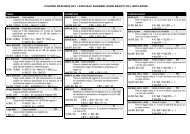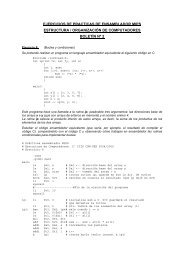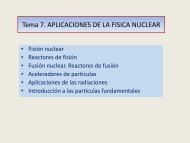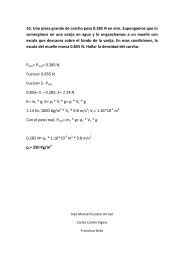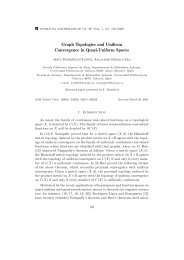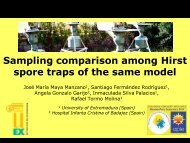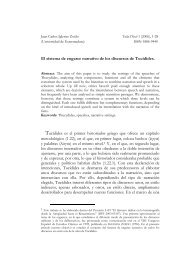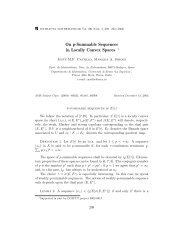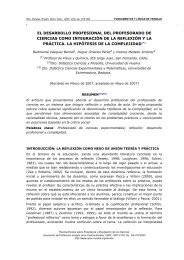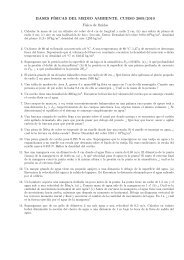The relationships between Poaceae pollination levels and cereal ...
The relationships between Poaceae pollination levels and cereal ...
The relationships between Poaceae pollination levels and cereal ...
You also want an ePaper? Increase the reach of your titles
YUMPU automatically turns print PDFs into web optimized ePapers that Google loves.
Aerobiologia 16: 281–286, 2000.© 2000 Kluwer Academic Publishers. Printed in the Netherl<strong>and</strong>s.281<strong>The</strong> <strong>relationships</strong> <strong>between</strong> <strong>Poaceae</strong> <strong>pollination</strong> <strong>levels</strong> <strong>and</strong> <strong>cereal</strong> yieldsAdolfo F. Muñoz 1 , Inmaculada Silva 2 & Rafael Tormo 3∗1 Departamento de Biología y Producción de los Vegetales, Escuela de Ingenierías Agrarias, Universidad de Extremadura,Spain; 2 Departamento de Electrónica e Ingeniería Electromecánica, Escuela de Ingenierías Agrarias,Universidad de Extremadura, Spain; 3 Departamento de Biología y Producción de los Vegetales, Facultad deCiencias, Universidad de Extremadura, Spain( ∗ author for correspondence: e-mail: ratormo@unex.es)Received 16 February 2000; accepted in final form 17 February 2000Key words: <strong>cereal</strong> yields, <strong>Poaceae</strong> airborne pollen, <strong>pollination</strong>AbstractWe analyze the possible <strong>relationships</strong> <strong>between</strong> the annual <strong>levels</strong> of Gramineae <strong>pollination</strong> <strong>and</strong> <strong>cereal</strong> yields inBadajoz province (Spain). <strong>The</strong> <strong>pollination</strong> parameters studied were the mean annual pollen concentration <strong>and</strong> theconcentrations of March, April, May, June, July, <strong>and</strong> August, <strong>and</strong> the yield parameter was taken to be each crop’syield (in t/ha) as well as the mean yield of all the province’s <strong>cereal</strong> crops.<strong>The</strong> most notable results were: the relationship <strong>between</strong> the June pollen concentrations <strong>and</strong> the yields of dryl<strong>and</strong><strong>cereal</strong>s (wheat, barley, oats, rye, <strong>and</strong> triticale), the lack of correlation <strong>between</strong> the pollen parameters <strong>and</strong> the yieldsof irrigated crops (maize, rice, <strong>and</strong> sorghum), <strong>and</strong> lastly the significant relationship <strong>between</strong> the mean <strong>cereal</strong> yields<strong>and</strong> both the mean annual <strong>pollination</strong> <strong>and</strong> the May <strong>and</strong> June concentrations. At least in the case of the dryl<strong>and</strong>crops, these <strong>relationships</strong> are explained by the similarity in the effect of environmental conditions on both the wildflora <strong>and</strong> the <strong>cereal</strong> crops.IntroductionSince COUR <strong>and</strong> VAN CAMPO (1980) showed therelationship that exists <strong>between</strong> the <strong>pollination</strong> levelof some cultivated anemophilous species <strong>and</strong> theirsubsequent yields, there have been several studiestesting this forecasting model. Initially the studiescentred on vineyard grapes, olives, <strong>and</strong> <strong>cereal</strong>s, witha recent concentration of work on olive growing(C<strong>and</strong>au et al., 1996; Fornaciari et al., 1998) <strong>and</strong>vineyards (Besselat <strong>and</strong> Cour, 1990; González <strong>and</strong>C<strong>and</strong>au, 1995; Cristofolini <strong>and</strong> Gottardini, 1998).Citrus fruit (Montanarella, 1998) <strong>and</strong> hazelnuts(Lletjos et al., 1993) have also been studied from thispoint of view, <strong>and</strong> some authors have even attemptedto establish <strong>relationships</strong> <strong>between</strong> pollen production<strong>and</strong> forestry yields (Hyde, 1963; Roure <strong>and</strong> Belmonte,1988).<strong>The</strong> usefulness of the method is highly variable,depending on the crop, the equipment used <strong>and</strong> theproduction zone. Thus Riera (1995), in reviewing thegreatest errors that can appear in studies on vineyards,finds them to lie <strong>between</strong> 2.3% <strong>and</strong> 22.4%, accordingto the season. <strong>The</strong> time <strong>between</strong> forecast <strong>and</strong> productionalso varies according to the crop: it is 1.5 to2 months for grapes, 4 to 5 months for olives, <strong>and</strong>7 to 8 months for hazelnuts, according to the citedauthor.<strong>The</strong> present work is an attempt to verify thepossible existence of a direct relationship <strong>between</strong> thelevel of Gramineae <strong>pollination</strong> <strong>and</strong> <strong>cereal</strong> yield withinthe province of Badajoz. <strong>The</strong> data used are from apollen trap situated in the capital of the province. <strong>The</strong>study was carried out using different monthly pollenparameters from March to August as well as the meanannual <strong>pollination</strong> level, <strong>and</strong> relating them to the yields
282(t/ha) of the eight main <strong>cereal</strong> crops in the years from1993 to 1998.degrees of significance in the correlations: p < 0.01(***), 0.01 < p
283Figure 1. Total concentrations from March to August, <strong>and</strong> mean annual Gramineae pollen concentration (grains/m 3 ).Table 1. Production data (t), area under cultivation (ha), <strong>and</strong> yields (t/ha) for the crops studied in the provinceof Badajoz.Wheat Barley Oats Maize Sorghum Rice Rye Triticale1993Production 11430 3060 1620 3420 481 – – 100Area 94515 83300 23700 380 233 – – 2189Yield 0.12 0.04 0.07 9.00 2.06 0.051994Production 140925 179552 51720 52500 28500 39000 600 6400Area 75400 92000 40000 7500 9500 6500 700 4000Yield 1.87 1.95 1.29 7.00 3.00 6.00 0.86 1.601995Production 28374 25900 4360 10150 250 500 200 500Area 98920 89920 41200 1450 100 100 750 4500Yield 0.29 0.29 0.11 7.00 2.50 5.00 0.27 0.111996Production 216901 109552 28896 292080 851 119859 5200 11000Area 96790 76480 42000 30000 120 17052 4000 6080Yield 2.24 1.43 0.69 9.74 7.09 7.03 1.30 1.811997Production 186377 58807 17962 412764 126000 10350 500 7200Area 117350 70470 41000 42400 18000 16511 900 6000Yield 1.59 0.83 0.44 9.74 7.00 0.63 0.56 1.201998Production 186300 69900 33500 448500 600 121800 800 6200Area 97270 37750 36000 39000 800 17400 700 4100Yield 1.92 1.85 0.93 11.50 0.75 7.00 1.14 1.51
284Table 2. Correlation matrix <strong>between</strong> monthly Gramineae pollen concentration <strong>and</strong> the yields of the different crops includingthe average yields. <strong>The</strong> values are the Pearson coefficient correlation (r) <strong>and</strong> the probability of this being zero (p).Wheat Barley Oats Rye Triticaler p r p r p r p r pMean annual 0.717 0.1091 0.600 0.2079 0.475 0.3410 0.975 0.0046 0.719 0.1070pollenMarch 0.140 0.8227 −0.029 0.9631 −0.094 0.8803 −0.090 0.8861 0.084 0.8935April 0.466 0.4291 −0.013 0.9835 −0.052 0.9344 0.375 0.5336 0.450 0.4476May 0.667 0.1477 0.533 0.2763 0.412 0.4172 0.871 0.0547 0.670 0.1452June 0.789 0.0622 0.805 0.0536 0.713 0.1118 0.951 0.0129 0.798 0.0573July 0.272 0.6024 0.083 0.8765 0.053 0.9204 0.765 0.1318 0.276 0.5960August 0.791 0.1071 0.433 0.3909 0.321 0.5355 0.465 0.4300 0.684 0.1337Maize Sorghum Rice Average yieldr p r p r p r pMean annual 0.587 0.2208 0.232 0.6577 0.630 0.2551 0.794 0.0594pollenMarch 0.638 0.2463 0.083 0.8949 −0.641 0.2435 −0.027 0.9661April 0.047 0.94 03 0.911 0.0312 −0.076 0.9028 0.560 0.3264May 0.341 0.5088 0.343 0.5061 0.680 0.2066 0.795 0.0589June 0.681 0.1361 −0.035 0.9477 0.566 0.3204 0.769 0.0740July 0.689 0.1300 0.233 0.6573 −0.016 0.9798 0.195 0.7118August 0.726 0.1024 0.590 0.2179 −0.377 0.5311 0.648 0.1638Figure 2. Total Gramineae pollen concentrations measured in June (grains/m 3 ) versus dryl<strong>and</strong> <strong>cereal</strong> yields (t/ha). In each case, the calculatedregression line is plotted.
285Figure 3. Mean <strong>cereal</strong> yield (t/ha) versus total Gramineae pollen concentrations measured in May <strong>and</strong> June (A), <strong>and</strong> versus mean annualconcentrations (B) in grains/m 3 .expressed as t/ha, since part of the variation in productionmay be due to the major fluctuations in area undercultivation for each of the crops from one year tothe next. Thus for instance, the barley production for1994 was 179 552 t, more than twice that of 1998with 69 900 t. On the basis of area under cultivation,however, 92 000 ha <strong>and</strong> 37 750 ha, respectively thetwo years have similar yields in t/ha.It is first of all notable that, as a result oftesting the forecasting value of the Gramineae airbornepollen concentration using different parameters in theestimate of <strong>cereal</strong> yields in the province of Badajoz,the regressions that were calculated presented a lowlevel of significance.In the case of the dryl<strong>and</strong> <strong>cereal</strong>s, the best estimatorwas the June pollen concentration, which waspositively correlated with crop yields. <strong>The</strong> correspondingregression lines may be divided into twogroups according to their slope: that of wheat, barley,<strong>and</strong> triticale which present slopes with values of b<strong>between</strong> 0.00030 <strong>and</strong> 0.00035, <strong>and</strong> that of oats <strong>and</strong>rye, with values of b of 0.00016 <strong>and</strong> 0.00018.
286To underst<strong>and</strong> this relationship, one must firstlytake into account that these crops, with the exceptionof rye, are self-fertilizing species whose <strong>pollination</strong>takes place mostly within the closed flower,with hardly any release of pollen into the air(VALDEYRON 1984). <strong>The</strong> relationship <strong>between</strong> theGramineae <strong>pollination</strong> <strong>levels</strong> <strong>and</strong> <strong>cereal</strong> yields cantherefore only be understood at the level of thephysiological relationship <strong>between</strong> the status of thewild Gramineae <strong>and</strong> that of the cited crop species, withthe expectation that factors favouring the <strong>pollination</strong>of the former will favour the fruit-set of the latter.Because much of the dryl<strong>and</strong> <strong>cereal</strong> harvesting is donein June, there may be an effect of the resuspensionin the air of part of the pollen as a result of themechanized harvesters. Another effect might be thatwhen the year’s weather conditions have favoured thedevelopment <strong>and</strong> flowering of Gramineae that comeinto flower in this month, there is a concomitantgood development <strong>and</strong> subsequent fruit-set of the crop<strong>cereal</strong>s.With respect to the irrigated crops – rice, maize,<strong>and</strong> sorghum – their yields show no uniform correlationwith the pollen parameters studied. <strong>The</strong> explanationof this could be that their growing conditionsinvolve an alteration of the environment which hasseparated the reproductive behaviour of these plantsfrom those that grow in wild conditions <strong>and</strong> whichwould be to a greater degree at the mercy of soil <strong>and</strong>weightier conditions.In general terms, however, the mean yields ofthe <strong>cereal</strong>s grown in Badajoz do show a significantcorrelation with the mean annual Gramineae pollencontent <strong>and</strong> with the concentrations of this pollenmeasured in May <strong>and</strong> June. Overall, this shows that thephysiological responses of the Gramineae are generalized:conditions which affect the development ofwild plants, the sources of airborne pollen, likewiseaffect the development of the crop <strong>cereal</strong>s. Amongstthe environmental parameters that have been studied<strong>and</strong> that affect Gramineae <strong>pollination</strong>, temperatures<strong>and</strong> rainfall are considered as of major importance(NORRIS-HILL, 1997).In the case of the mean yields of the <strong>cereal</strong>s, theforecasting character of the pollen parameters mightbe of great value, since even in May they allow thegoodness of the yields to be estimated. When each<strong>cereal</strong> is considered separately, these parameters losetheir predictive value, since the present results haveshown that their estimates are of a low level of significance,only valid for some late crops, since by Juneone is able to forecast crop production on the basis ofreal harvesting data.ReferencesBesselat B. <strong>and</strong> Cour P.: 1990, La prèvision de la productionviticole á l’aide de la technique “Capture du pollen”. Inf. Tech.CEMAGREF 78(3), 1–4.C<strong>and</strong>au P., González F.J., Morales J. <strong>and</strong> Tomás C.: 1996, Prediccionesde cosecha en el olivar basadas en estudios aeropalinológicos:Resultados de seis años de muestreo en la Campiña deCórdoba (SO de España). Actas del 1 ◦ Simposio Europeo deAerobiología 149. Santiago de Compostela.Cour P. <strong>and</strong> van Campo M.: 1980, Prèvisions de récoltes á partir ducontenu pollinique de l’atmosphère. C. R. Acad. Sc. Paris 290,1043–1046.Cristofolini F. <strong>and</strong> Gottardini E.: 1998, Concentration of airbornepollen of Vitis vinifera L. <strong>and</strong> yield forecast: A case study at S.Michele all’Adige, Trento. Abstracts 6th International Congresson Aerobiology 291. Perugia.Fornaciari M., Pieroni L., Rossi A.C. <strong>and</strong> Romano B.: 1998,Yield forecasting model for the olive. Abstracts 6th InternationalCongress on Aerobiology 281. Perugia.González F.J. <strong>and</strong> C<strong>and</strong>au P.: 1995, La aeropalinología comomodelo de previsión de cultivos. I. Los viñedos del Condado deHuelva. Polen 7, 59–63.Hyde H.A.: 1963, Pollen-fall as a means of seed prediction in certaintrees. Grana 4, 217–230.Lletjos L., Bartroli R., Esteban A. <strong>and</strong> Riera S.: 1993, Forecastinghazelnut (Corylus avellana L.) crop production basedon monitoring airborne pollen concentration. IV InternationalSymposium on Fruit, Nut, <strong>and</strong> Vegetable ProductionEngineering. Valencia-Zaragoza.Montanarella L.: 1998, <strong>The</strong> application of aeropalynologicalmethods to the early forecast of european wine, olive oil<strong>and</strong> Citrus fruit production: From a local to a national forecast.Abstracts 6th International Congress on Aerobiology 283.Perugia.Norris-Hill J.: 1997, <strong>The</strong> influence of ambient temperature on theabundance of <strong>Poaceae</strong> pollen. Aerobiologia 13, 91–97.Riera S.: 1995, Estimación de cosechas en cultiuvos leñosos a partirdel contenido polínico de la atmósfera. Fruticultura Profesional68, 17–29.Roure J.M. <strong>and</strong> Belmonte J.: 1988, Primeros resultados para elestudio de las relaciones entre la producción polínica y la producciónde biomasa de las comunidades forestales. VI Simposio dePalinología A.P.L.E. Salamanca, pp. 205–209.Valdeyron G.: 1984, Production de semenses pour quelques plantesde gr<strong>and</strong>e culture: céréales, graminées fourragères, betteraveà sucre. In: P. Pesson <strong>and</strong> J. Louveaux (eds), Pollinisation etproductions végétales. Paris, pp. 143–162.




